By CLAUDE ARPI
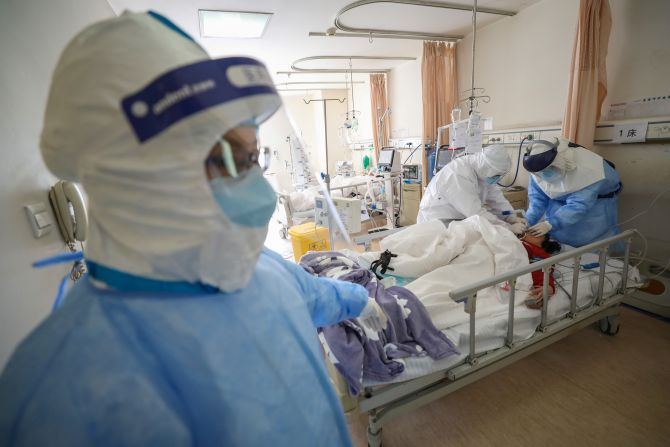 China started information warfare to prove to the world that COVID-19, which originated in China, does not have its origin in China.
China started information warfare to prove to the world that COVID-19, which originated in China, does not have its origin in China.
Zhao Lijian, a spokesperson of the ministry of foreign affairs in Beijing, tweeted that the US army had brought the dreaded virus to Wuhan.
Wang Yi, China's state councilor and foreign minister, phoned his Indian counterpart Dr S Jaishankar that the virus should not be called 'Chinese', as it would stigmatise the country and would be detrimental to 'international cooperation'.
The stakes are high for Beijing: externally, it does not want to appear as the bad guy who spread the virus all over the planet with the drastic consequences seen today (more than 1.7 million affected, more than one lakh casualties, while three billion human beings live under confinement, all this with unpredictable and incalculable economic and social implications), but also internally, where General Secretary Xi Jinping's is more and more questioned within the Chinese Communist arty.
The objective of Beijing's information warfare exercise is to make the world forget to look for the real origin of the virus, something vital to avoid the recurrence.
Interestingly, a group of Chinese scholars led by Botao Xiao of the South China University of Technology wrote a paper in February for the Natural Science Foundation of China; it dealt with 'The possible origins of 2019-nCoV coronavirus'.
After searching around the seafood market in Wuhan, said to be the epicentre of the outbreak, they identified two laboratories conducting research on bat coronavirus.
The first one, the Wuhan Centre for Disease Control & Prevention is located 280 meters from the market.
The scientists found that 'urgery was performed on the caged animals and the tissue samples were collected for DNA and RNA extraction and sequencing. The tissue samples and contaminated trashes were a source of pathogens.'
It is not proof, but a possibility to be studied fully.
The second laboratory, the Wuhan Institute of Virology of the Chinese Academy of Sciences, is located 15 kilometres from the seafood market.
It was recently in the news when Dr Chen Wei, a lieutenant general in the People's Liberation Army, took over the management.
Xiao and his colleagues concluded: 'Somebody was entangled with the evolution of 2019-nCoV coronavirus. In addition to origins of natural recombination and intermediate host, the killer coronavirus probably originated from a laboratory in Wuhan. Safety level may need to be reinforced in high risk bio-hazardous laboratories.'
'Regulations may be taken to relocate these laboratories far away from the city centre and other densely populated places,' Xiao and his colleagues recommended.
All this means that more serious and independent studies need to be undertaken to find out more about the origin of the 'international' virus.
The French Connection
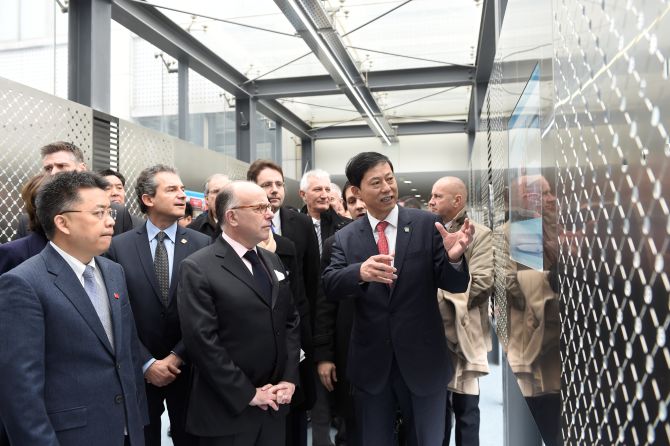
IMAGE: Then French prime minister Bernard Cazeneuve visits a laboratory in Wuhan, February 23, 2017. Photograph: China Daily/Reuters
On February 23, 2017, Bernard Cazeneuve, then the French prime minister, inaugurated the 'P4' laboratory in Wuhan; he declared: 'France is proud and happy to have contributed to the construction of the first high biological security 'P4' laboratory in China.'
'Designed by French experts and started in 2011, this cutting-edge tool is a central element in achieving the 2004 intergovernmental agreement on Franco-Chinese cooperation for the prevention and fight against emerging infectious diseases,' Cazeneuve declared.
The tragedy is that this investment did not prevent or even foresee the coming disaster.
Cazeneuve also said that French engineering companies and equipment manufacturers had 'perfectly mastered these laboratory technologies which are a major asset to guarantee the safety of populations, while developing a national capacity to manage biological risk.'
'Ladies and gentlemen,' Cazeneuve declared, 'this laboratory that we have built together will be a spearhead in our fight against emerging diseases. It will greatly increase China's ability to conduct cutting-edge research and responding effectively to the emergence of infectious diseases that threaten people across the globe.'
As I write these lines, 1.2 lakh French people are affected by the virus and near 13,000 have lost their lives.
The Chinese government should certainly be questioned: What happened with the French tax-payers' money? Has it been properly used?
Close Foreign Collaboration
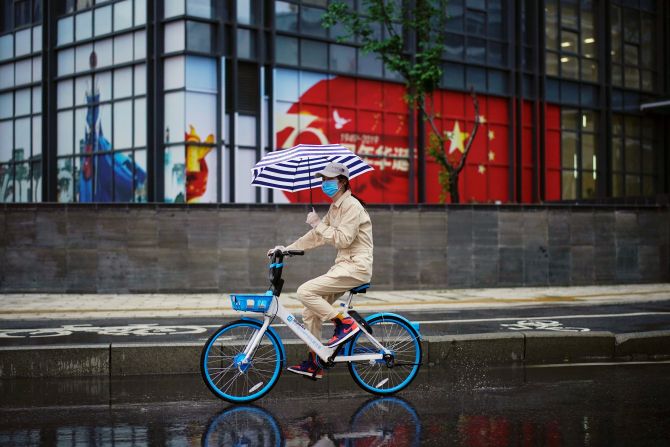
IMAGE: A street in Wuhan, April 10, 2020. Photograph: Aly Song/Reuters
A 'P4' Laboratory is accredited to work on 'class 4 pathogens'; it has the necessary security safety and the staff is trained to work with highly dangerous viral or bacterial agents, which could trigger high mortality rates, mostly without protective vaccine or effective treatment (as is the case of the COVID-19).
One of the questions which needs an answer one day is why the Chinese scientists did see not the pandemic coming or did they see it and were not allowed to speak?
The Wuhan P4 laboratory benefited from the support of the Jean-Merieux laboratory in Lyon, (working under the French National Institute of Health and Medical Research or INSERN), which is considered one of the best in the world.
In 2017, its director, Herve Raoul explained to Science & Sante magazine, why France was involved in Wuhan; he asserted that the cooperation involved some fifty scientists, under the aegis and piloted by the INSERN; the Nipah virus was the main subject of their studies at that time.
'We have very little knowledge of this topic. The work will cover some fundamentals aspects (replication, dispersion in the organisation, dynamic targeting), but also other aspects, including preclinical testing and development of diagnostic tools, as there is no product on the market,' he said.
Other projects are currently discussed, but are still at the preliminary stage, added Dr Raoul, who cited the Ebola virus 'which interests Chinese researchers'.
To deal with the emergence of highly pathogenic microorganisms, a strategy needed to be worked out; it meant fast responses, with containment zones that would allow 'to drive safely diagnostic activities essential to patient management, but also research for development prevention and treatment tools.'
'The P4 laboratories are at the heart of these challenges... it calls for a reflection on the coordination of in situ responses in time of crisis,' noted Dr Raoul. All this sounds contemporary.
The magazine then asked Dr Raoul: 'Will China become a great power in the overall response to the risk of infectious emergence or re-emergence?' To which the scientist answered: 'This is indeed one of China's ambitions. Further, our Chinese colleagues are interested in a collaboration with the European ERHINA project -- for European Research Infrastructure on Highly Pathogenic Agents -- which will be headquartered in France.'
After the present fiasco, this is probably compromised now.
Concerns about Pathogens Escape
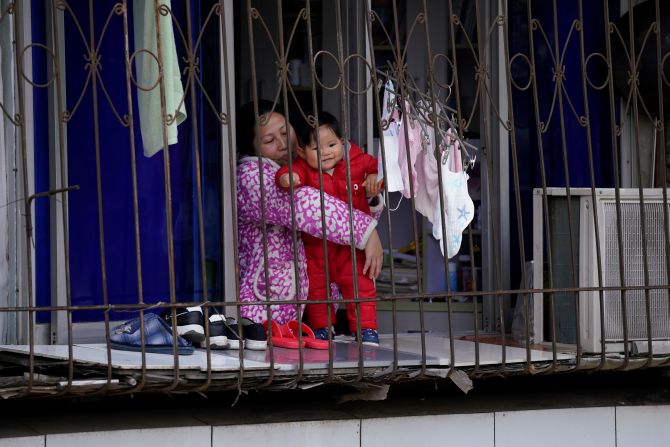
IMAGE: A woman and a baby are seen at a window of a blocked residential community in Wuhan, April 1, 2020. Photograph: Aly Song/Reuters
The day that Cazeneuve inaugurated the P4 lab, the serious review Nature, published an article on the Wuhan Virology Institute: 'Maximum-security bio-safety facility nears approval, sparking excitement and concern'.
The author remarked: 'A laboratory in Wuhan is on the cusp of being cleared to work with the world's most dangerous pathogens. The move is part of a plan to build between five and seven biosafety level-4 (BSL-4) labs across the Chinese mainland by 2025, and has generated much excitement, as well as some concerns.'
The scientific magazine explained: 'Some scientists outside China worry about pathogens escaping, and the addition of a biological dimension to geopolitical tensions between China and other nations. But Chinese microbiologists are celebrating their entrance to the elite cadre empowered to wrestle with the world's greatest biological threats.'
George Gao, director of the Chinese Academy of Sciences Key Laboratory of Pathogenic Microbiology and Immunology in Beijing, told Nature: 'It will offer more opportunities for Chinese researchers, and our contribution on the BSL-4-level pathogens will benefit the world.'
The National Bio-safety Laboratory in Wuhan was the first 'P4' on the Chinese soil; it had just been certified by the China National Accreditation Service for Conformity Assessment in January 2017.
CNAS said the examination of the lab's infrastructure, equipment and management, paved the way for the ministry of health to give its approval; according to Nature: 'The criteria for certification include filtering air and treating water and waste before they leave the laboratory, and stipulating that researchers change clothes and shower before and after using lab facilities.'
But the magazine admitted that there were concerns as well as controversies surrounding some of these high tech labs, one in Japan in particular.
The Army Takes Over
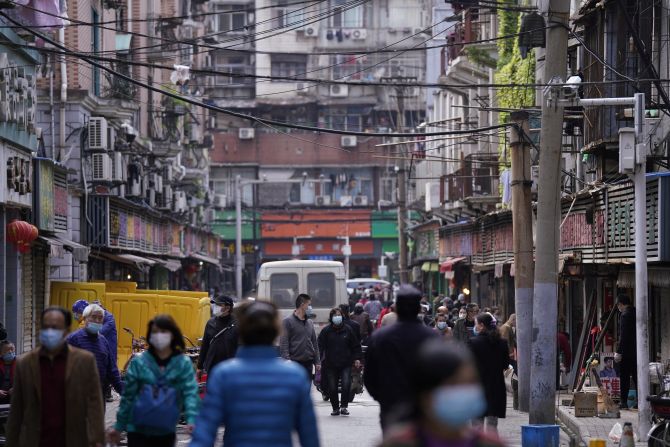
IMAGE: A street market in Wuhan, April 6, 2020. Photograph: Aly Song/Reuters
Surprisingly, a Chinese PLA general took over the institute in Wuhan at the end of January.
Lieutenant General Chen Wei, a researcher at the Military Medical Research Institute of the Academy of Military Sciences, became responsible for the research; since then the lady general is said to have found the first vaccine on March 16.
Was the possibility of a PLA takeover thought of at the time of Cazeneuve's visit to Wuhan? Probably not.
Why this drastic move?
Either an incident took place in the lab (and we will not know for years maybe) or the PLA did not trust the civilians to run the lab.
A couple of weeks later, a high-level meeting chaired by Xi Jinping took place in Beijing; the next day, the Chinese ministry of science and technology released a new directive for the people working in the lab: "Instructions on strengthening bio-security management in microbiology labs that handle advanced viruses like the novel coronavirus."
Was there a problem? Again no answer.
All this raises many questions which nobody is even ready to discuss.
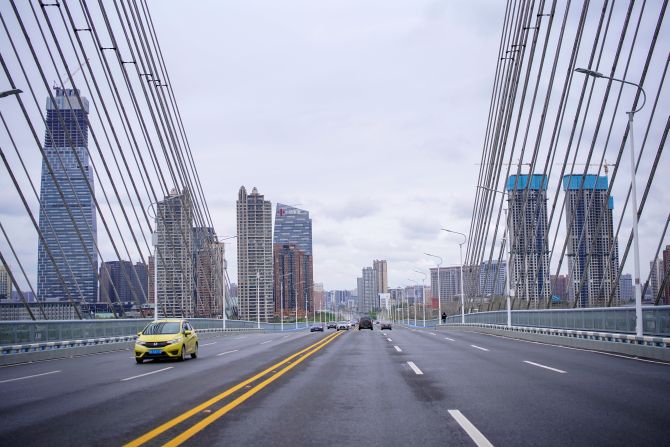
IMAGE: A view of a street in Wuhan, March 28, 2020. Photograph: Aly Song/Reuters
Many more stories could be added, like the case of Dr Shi Zhengli, who earned a PhD from Monpelleir University in France and was part of a team working on a coronavirus jointly with US doctors till 2014; the project was shut down by the US administration ... for being too risky.
Later, Dr Shi continued her coronavirus research at the Institute of Virology in Wuhan.
Beijing is strangely silent on all this.
Incidentally, last week, a member of Cobra, the emergency committee led by British Prime Minister Boris Johnson, said while the latest intelligence in the UK did not dispute the virus was 'zoonotic' -- originating in animals -- it could not rule out that the virus first spread to humans after leaking from a Wuhan laboratory.
Indeed, an affair to follow closely.
No comments:
Post a Comment